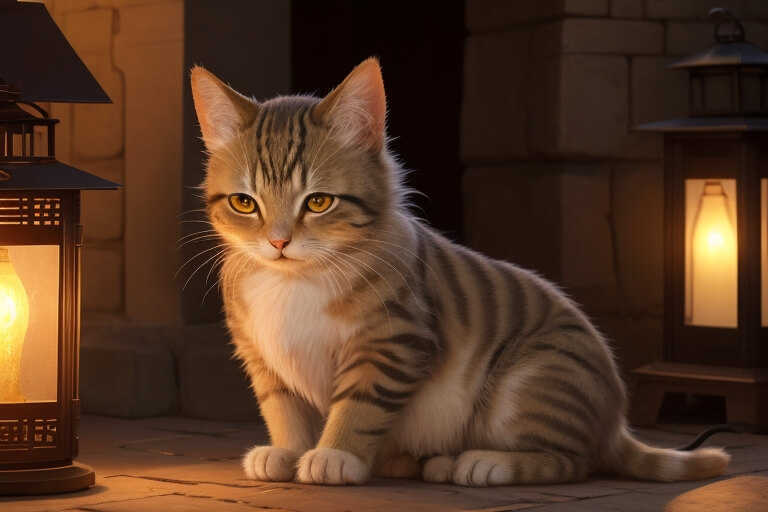Cats, those enigmatic and graceful creatures, have captivated human hearts for centuries. Beyond their role as beloved pets, cats hold a special place in the cultural tapestries of various countries around the world.
Ancient Egypt
The majestic Nile River, pyramids that touch the sky, and the worship of cats – these elements form an iconic triad of Ancient Egypt. Cats were revered as sacred beings in Egyptian society. Bastet, the goddess of home, fertility, and childbirth, was often depicted with the head of a lioness or domestic cat. These feline creatures were believed to protect homes from evil spirits and vermin, symbolizing both domestic comfort and divine guardianship.
Cats held such a significant place in ancient Egypt that they were often likened to household deities. They were pampered and adorned with jewelry, living in the lap of luxury. When a cat passed away, it was common for the entire household to mourn, shaving their eyebrows as a sign of respect. In essence, cats were not just pets but revered members of the family, and their significance extended to religious rituals as well.
Japan
In the Land of the Rising Sun, cats are celebrated in the form of the “maneki-neko,” or the beckoning cat. This figurine, often seen in shop  windows and homes, is believed to bring good luck and fortune to its owner. The Maneki-neko usually features a cat with one paw raised in a beckoning gesture, beckoning customers, or wealth.
windows and homes, is believed to bring good luck and fortune to its owner. The Maneki-neko usually features a cat with one paw raised in a beckoning gesture, beckoning customers, or wealth.
Japanese folklore also tells stories of the “bakeneko” and “nekomata,” mythical cat creatures with supernatural abilities, including shapeshifting. These tales portray cats as both protectors and tricksters, with the power to influence the lives of humans. Cats continue to hold a special place in Japanese culture, representing prosperity and protection.
The maneki-neko’s origin is rooted in legends that highlight cats’ role in safeguarding against evil spirits and misfortune. Cats were often considered guardians of homes, and their presence was believed to ward off malevolent forces. This symbolism continues to thrive, and maneki-neko figurines are a common sight in modern Japan, gracing businesses and households alike, as people seek to invite good fortune and protection into their lives.
Turkey
In the bustling coffee houses, or “kıraathane,” of Turkey, you’ll often find a resident cat lounging on the tables or purring in a corner. These cats have become a cherished part of Turkish coffee culture, where they symbolize hospitality and relaxation. Their presence is believed to bring good luck to the establishment and its patrons.
Turkish folklore is rich with tales of “Kadınlar Matinesi,” or “The Women’s Matinee,” in which cats and other animals hold secret gatherings, sharing stories and wisdom. In Istanbul, the city’s cats are so beloved that they have their own neighborhoods and caretakers who provide food and shelter for them.
The relationship between cats and Turkish culture extends beyond mere symbolism. These cats play a practical role in coffee houses by helping to control pests, such as rats and mice, thereby contributing to the cleanliness and comfort of these establishments. In this way, cats are not just revered but also appreciated for their practical contributions to daily life.
Scotland
In the misty highlands of Scotland, the legend of the Cat Sìth (pronounced “cat shee”) prevails. This mythical creature is said to resemble a large black cat with a white spot on its chest. The Cat Sìth was believed to have the power to steal the souls of the deceased before they could reach the afterlife. To appease this spectral feline, the Scots would leave out saucers of milk on their doorsteps on the night of Samhain (Halloween).
While the Cat Sìth was feared, it also had a positive aspect. In Scottish folklore, it was thought that by keeping a house cat indoors on Samhain, they could prevent it from being possessed by the Cat Sìth, thus protecting the household.
The legend of the Cat Sìth reflects the deep connection between Scottish culture and the mystical world. Cats, in this context, are both mysterious and respected, embodying the duality of folklore where they are both feared and appeased in an effort to navigate the supernatural realm.
Ireland
In Irish folklore, cats are associated with the mystical and enchanting world of fairies. The belief goes that cats possess the unique ability to see the fairies, who are often invisible to humans. As a result, cats are considered as guardians against the mischievous antics of these supernatural beings. In a land steeped in myth and legend, the presence of cats in Irish culture goes far beyond mere superstition.
In the Irish countryside, where ancient traditions and beliefs still hold sway, cats are held in high regard. People in Ireland often treat their cats with great care and respect, understanding that mistreating a cat could anger the fairies. To harm a cat in any way is seen as inviting the wrath of the mystical realm, a prospect not to be taken lightly in a country where traditions run deep.
Cats, with their enigmatic gaze and silent movements, embody the connection between the everyday world and the mystical one in Ireland. They are seen as the bridge between the mundane and the magical, and their presence in homes is not just for companionship but also for spiritual protection. The folklore surrounding cats in Ireland serves as a reminder of the enduring power of ancient beliefs in the modern world.
Myanmar
In Myanmar (formerly known as Burma), cats enjoy a unique and revered status within the cultural and religious landscape. Here, cats are not just cherished companions; they are considered sacred beings with a spiritual significance deeply rooted in Buddhist traditions.
 Buddhism plays a central role in Myanmar, and within its temples, cats have found a special place. These temple cats, known as “စိမ်းေကာင်” (pronounced “sein kaung”), are not only adored by the monks but also by the local community. They are often seen wandering peacefully amidst the serene surroundings of the monasteries.
Buddhism plays a central role in Myanmar, and within its temples, cats have found a special place. These temple cats, known as “စိမ်းေကာင်” (pronounced “sein kaung”), are not only adored by the monks but also by the local community. They are often seen wandering peacefully amidst the serene surroundings of the monasteries.
The belief is that these temple cats bring blessings, spiritual protection, and good fortune to the temples and the people who visit them. Their presence symbolizes a harmonious coexistence between humans and animals, and they are treated with great care and respect. It’s not uncommon to see monks sharing their meals with these feline companions or providing them with shelter.
Beyond their spiritual significance, these temple cats offer a sense of solace and tranquility within the sacred spaces they inhabit. Visitors to Myanmar’s temples often find a sense of calm and peace in the presence of these cats, as their serene demeanor aligns with the meditative atmosphere of the Buddhist monastic life.
In Myanmar, cats transcend the role of pets; they are living embodiments of the profound reverence and spiritual interconnectedness that characterizes the nation’s religious and cultural ethos. Their presence within the tranquil temple grounds adds a layer of enchantment to the profound spiritual experience one encounters when visiting these sacred sites.
